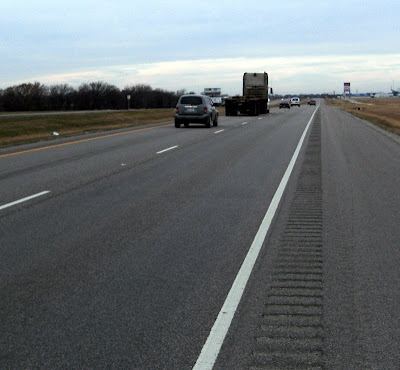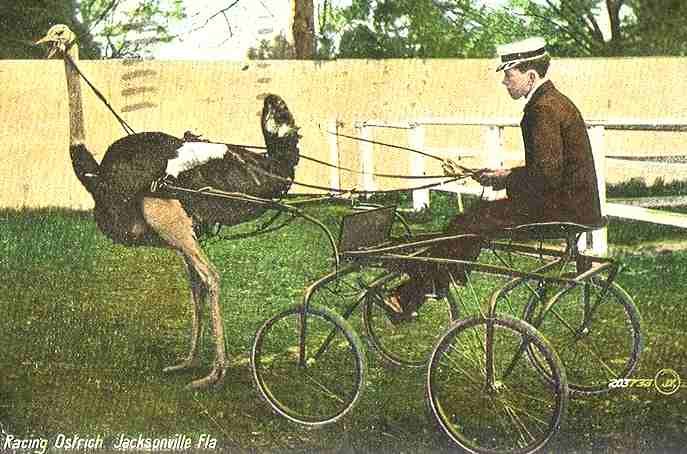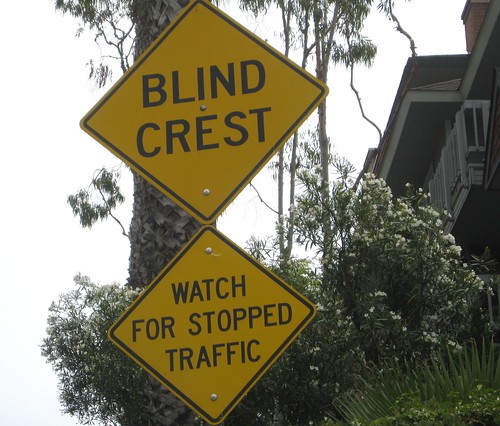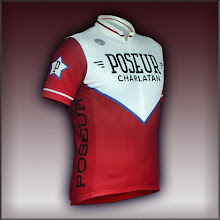So when I was done with the things I had to do in downtown Ennis, I headed out to Waxahachie for an appointment I had there. With a 18 mile trip before me, I figured that an hour and a half would be plenty of time.
I figured wrong.
This happened on Tuesday December 16.
I took Hwy 287; a four lane road with a center median and all the look of a limited access freeway except for all the driveways and cross streets. No signal lights for ten miles. Sixty five mile per hour posted speed limit. A shoulder of varying width from six inches to ten feet. A rumble strip straddling the transition from a resurface job, which in practice meant that the inside of the rumble strip was a couple inches higher than the outside edge. An occasional right and left turn only lane. Twelve foot wide travel lanes. Real smooth pavement on the roadway. [1]
My appointment was at three in the afternoon, and I rolled out of downtown Ennis just after one thirty.
As is usual when I take the lane on a road with a shoulder, I was frequently honked at. Isn’t the freedom of expression great? It makes it so much easier to spot the idiots!
What was unusual is that about half of the commercial trucks chose to identify their IQ! That is way high in my experience. As a percentage, maybe five to ten percent of private vehicles honked. The usual number chose to pass me on the right on the shoulder which is a crime in Texas. [2]
The First StopAfter a few miles. A State trooper’s vehicle passed me. He slowed and used a crossover to wait for me. As I passed his location, he got on his PA system and said; “For safety’s sake, will you please ride on the shoulder?”
I emphatically shook my head no and continued on my way.
When traffic permitted, he pulled onto the roadway and displayed his lights. I stopped and waited for him. [3] I regret that I am unable to remember his name.
“It’s dangerous to ride out there” he said.
“It’s even more dangerous on the shoulder.” I said. “Do you think drivers are so incompetent that they will run over objects in their path?”
“That’s what the rumble strips are for- to protect the idiots from themselves!”
He then painted a preposterous scenario. He said that if someone panicked and traffic backed up then I would be guilty of impeding traffic.
I pointed out one of Texas’s laws in the Texas Transpiration Code (TTC) and we discussed it for a while. I am reluctant to share it here until after my ticket is resolved with the city of Ennis. I see no point in helping the DA in convicting me by pointing out statutes I will defend myself with.
He then asked me for my ID. Good for him! He didn’t ask me for a driver’s license! I promptly began digging into my backpack to get it.
He asked me where I was going. “That away”’ I said, indicating down the road. He didn’t pursue the issue, as it was really immaterial to the traffic stop. [4]
Handing him my ID, he said that he would be writing me a warning.
“What is the charge?” I asked.
“Impeding traffic.”
“Will you be citing the section of the transportation code?”
“I’ll have to look it up for you”
As he returns to his vehicle, I pull out my camera. His dashcam is taking pictures of me, I am taking pictures of him.

About then another police unit pulls up. Officer XXX of the Ennis police department gets out and walks up to me.
What’s he saying to you?” he asks, indicating the trooper.
“He thinks I should be riding on the shoulder.”
Sergeant Joe Sifuentes informs me that Ennis police are getting a lot of calls complaining about me. Then, deciding the state trooper has things under control, wishes me a Merry Christmas and leaves.
The Texas Trooper returns and says that he can’t find the statute he was looking for, and he tells me I am free to go. He urges me to ride on the shoulder where he believes I will be safer. I thank him for his concern and wish him a Merry Christmas, and at the next gap in traffic, I merge onto the roadway again.

I found the State Trooper’s demeanor to be exemplary. He was polite, friendly and professional. Nonetheless, I think he felt it was his greater duty to enhance traffic flow rather than to expect road users to follow the rules.
The Second StopSoon enough, business 287 peels off of Hwy 287. It becomes a narrow two lane 55 MPH shoulderless chipsealed road for about two miles, and then it changes into a 30 mph narrow two lane residential road. It was on this residential part when a Waxahachie police officer pulls me over.
This young officer seemed to be in his mid twenties. He asked me to step off the roadway so he could talk to me safely rather than standing in front of his cruiser in view of the dashcam.
“Are Waxahachie drivers so incompetent that they can’t avoid a pedestrian on the street?”
I think this question derailed his agenda. He took a moment to get started again.
“Are you coming from Ennis?” I nod in affirmation. “We have been getting a lot of calls about you, they say you are wandering all over the road.”
“I wasn’t wandering at all, I was riding in the center of the lane, just like they were.”
“Your supposed to ride on the right half of the lane.”
I deny that his understanding is correct. “You should refresh your memory. The part you want is section 551.103.”
This rattles him as well, and he is now clearly uncomfortable with the conversation. He quickly ends the traffic stop, and I again resume my trip. Alas, I am too late for the meeting and my trip was for naught.
I strike up a conversation with someone while I rest, and perhaps get too involved in it, as it is dusk when I begin my return leg. I re-trace my path onto business 287. Only a couple of idiots identify themselves.
I turn on my rear blinky just before I merge into traffic on Hwy 287.
Another ten miles of serial rudeness ensues.
The Third StopAs I exit Hwy 287 onto the business 287 near Ennis, I am again pulled over for a traffic stop. It is Sergeant Joe Sifuentes again! He doesn’t even bother to get out of his cruiser. He is polite and professional, but he is responding to the urging of dispatchers. I doubt he would've pulled me over on his own initiative.
He too proposes a preposterous analysis. He asked me why all those cars were taking evasive action, changing lanes, slamming on their breaks and swerving onto the shoulder? I said it was because the drivers were incompetent and impatient.
No, he said, it was because of you! I denied that it was my fault that they were passing me illegally; On the right and on the shoulder. Who’s fault was it then, he asked, incredulous at my reply.
I said that I had no power to steer an automobile. Those motorists have a legal duty to observe my right-of-way.
He then asked me for my name and such, as he needed to write a report of the stop so they have a record of my behavior in case something were to happen to me.
I laughed out loud at this. “So that I can be blamed if someone runs into me?”
Just at this point, our communication broke down due to an unfortunate collection of events. I spoke something to him and laughed again. He said something to me at the same time (cross-talked) and so I did not hear what he said, and some traffic passed by further muddying the sound for each of us. But he got angry that I laughed, thinking I was reacting to what he said.
I was realizing at that moment that his “windshield view” common sense was going to prevent him from ever believing that being legally in the way was safer than being out of the way on the shoulder. I was laughing at the absurdity of my attempting to convince him. Sadly, it caused him to harden his attitude toward me.
“Will you be laughing when someone runs you down?” He asked sharply.
“Do you ride a bicycle?” I asked him. He said he never does. I said; “I have ten thousand miles on that very bicycle right there, ridden in just this same way, and I am still here to talk about it. In this conversation, one of us is an expert at cycling and the other one is not.”
After a few more sage words of advice for me along the lines of the futility of being right but dead, he returned my ID and I continued on my way.
Reflections About These Events
Ignorance about most traffic laws is widespread in my community, and when it comes to bicycle specific traffic law the ignorance is even more acute.
It is first made apparent by the honking. For example, on the two lane near Waxahachie, a motorist a fair distance back honks at me. Short and polite: Honk-honk. After a moment, again: Honk-honk. And then, when I don’t disappear into thin air (It is hard to know what this motorist expected, as we were traveling on a ten foot wide lane- he would have had to encroach onto oncoming lanes no matter where I was laterally in the lane!): HONK hooonk hoooonk!
Many honk at me while sailing past me, unhindered, in the left lane. Perhaps they are expressing joy at finally coming across someone who is driving on the public road in a lawful manner!
In my presence, many many traffic laws were broken. But it was me, one of the few legal drivers, who was pulled over.
The State Trooper pulled me over on his own initiative, perhaps with genuine concern for me. I am sure that when he initiated his stop he was certain I was breaking some law, and he may have even had one or two in mind that failed to pan out.
The traffic stop by the Waxahachie police and the stop (Two stops?) by Ennis police were in response from phone calls dialed in to 911 lines. But once my behavior was observed, neither attempted to cite me for any offence. They just tried to convince me to ride where I believe it to be a compromise of my personal safety, for the purpose of enhancing the convenience of automobile drivers.
Mind you, I had no choice to opt out of the lectures. I had to stop under penalty of law. Bicyclists are just out for a lark anyway, right? It is folks in automobiles that are going somewhere important.
None of the illegal driving by licensed motorists were cited. Sergeant Joe Sifuentes even notes that he saw such behavior himself. He ignored all that, and pulled me over instead, even though he had not observed any unlawful behavior on my part.
Two officers commented that their departments had received many calls from motorist complaining that I was driving my bicycle in a legal manner. Why did that require a response by a patrol officer? Once the officer observed my driving, why did they continue with the stop?
Why couldn’t dispatchers tell motorists that bicycles are allowed to drive on the roadway?
The reason is that the whole of them are ignorant to what Texas law says. Because bicycle driving is uncommon, it is assumed that it is uncommon because it is illegal.
The result is that law abiding citizens are delayed, harassed and abused by law enforcement and by mistakenly outraged motorists. Meanwhile, the Texas Bicycle Coalition spends it’s legislative activities trying to pass new laws that are a simply a re-statement of current law.
Perhaps our bicycle advocates could work to change the real discrimination we Texas cyclists face. You know, something that would actually make Texas better for their constituents. (I know, I’m making crazy-talk again.)
Conquering the Frontiers of Ignorance
Perhaps our local police could become familiar with bicycle specific law if they are going to do something about scofflaw cyclists, and if they intend to respond to the uninformed opinion of angry Texans on the other end of a phone line.
I’ll even help them with a heads up for where to look:
Sec. 551 with a special emphasis on Sec. 551.103 (a)(4)(A) – I would suggest you read that part two or three times.
You should also become familiar with these sections which are important to understand when you are dealing with slow vehicles on the public road: Sec. 541.301, Sec. 545.002, Sec. 545.051, Sec. 545.058, Sec. 545.060, and Sec. 545.363
Ignorance can be defined as not knowing what you don’t know. One is not doomed to remain in ignorance forever. Those statutes there can start you on your path to enlightenment, if you want it.
 [1] I am using the legal definition of the word “roadway”. From the TTC:
[1] I am using the legal definition of the word “roadway”. From the TTC:
Sec. 541.302. (11) "Roadway" means the portion of a highway, other than the berm or shoulder, that is improved, designed, or ordinarily used for vehicular travel.
[2] Sec. 545.058
[3] Note to SteveA. I watched to see if he was pulling onto the shoulder before I crossed the edge line. As I did later as well.
[4] In Texas, one is required to tell a law enforcement officer his real name and his current address. We are not required to produce ID of any kind, but the officer is allowed to detain you until your identity can be confirmed. When you are operating a motor vehicle, you must be able to produce a driver’s license on demand.










